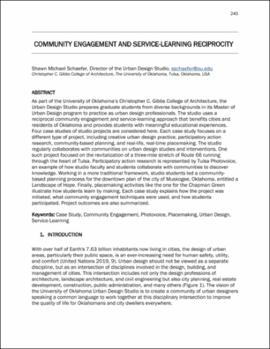| dc.contributor.author | Schaefer, Shawn Michael | |
| dc.date.accessioned | 2022-03-23T20:45:00Z | |
| dc.date.available | 2022-03-23T20:45:00Z | |
| dc.date.issued | 2022 | |
| dc.identifier.citation | Schaefer, Shawn Michael, "Community Engagement and Service-Learning Reciprocity," in Person, Angela M., Anthony Cricchio, and Stephanie Z. Pilat, eds. 2022. Proceedings of Schools of Thought: Rethinking Architectural Pedagogy, Norman, Oklahoma, March 5-7, 2020. University of Oklahoma Libraries: ShareOK. | |
| dc.identifier.uri | https://hdl.handle.net/11244/335074 | |
| dc.description | This paper was presented at the 2020 Schools of Thought Conference hosted by the Christopher C. Gibbs College of Architecture at the University of Oklahoma. | |
| dc.description.abstract | As part of the University of Oklahoma’s Christopher C. Gibbs College of Architecture, the Urban Design Studio prepares graduate students from diverse backgrounds in its Master of Urban Design program to practice as urban design professionals. The studio uses a reciprocal community engagement and service-learning approach that benefits cities and residents of Oklahoma and provides students with meaningful educational experiences. Four case studies of studio projects are considered here. Each case study focuses on a different type of project, including creative urban design practice, participatory action research, community-based planning, and real-life, real-time placemaking. The studio regularly collaborates with communities on urban design studies and interventions. One such project focused on the revitalization of a three-mile stretch of Route 66 running through the heart of Tulsa. Participatory action research is represented by Tulsa Photovoice, an example of how studio faculty and students collaborate with communities to discover knowledge. Working in a more traditional framework, studio students led a community-based planning process for the downtown plan of the city of Muskogee, Oklahoma, entitled a Landscape of Hope. Finally, placemaking activities like the one for the Chapman Green illustrate how students learn by making. Each case study explains how the project was initiated, what community engagement techniques were used, and how students participated. Project outcomes are also summarized. | |
| dc.language.iso | en_US | |
| dc.relation.ispartof | 2020 Schools of Thought Conference | |
| dc.relation.uri | https://hdl.handle.net/11244/335058 | |
| dc.rights | CC BY-NC-SA | |
| dc.rights.uri | https://creativecommons.org/licenses/by-nc-sa/4.0/ | |
| dc.subject | case study | |
| dc.subject | community engagement | |
| dc.subject | photovoice | |
| dc.subject | placemaking | |
| dc.subject | urban design | |
| dc.subject | service-learning | |
| dc.title | Community Engagement and Service-Learning Reciprocity | |
| dc.type | Article | |
| dc.description.peerreview | Yes | |
| dc.identifier.doi | 10.15763/11244/335074 | |
| ou.group | Christopher C. Gibbs College of Architecture | |


